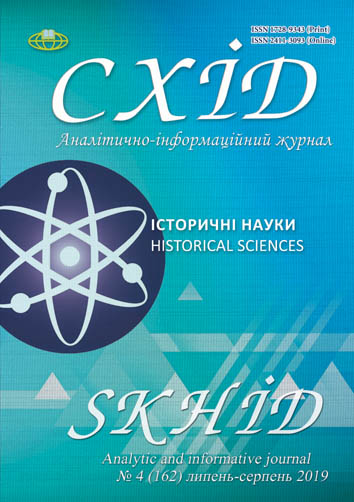The Family Archives as a Source for Estate’s Daily Life Reconstruction on Left-bank Ukraine in 19th Century
DOI:
https://doi.org/10.21847/1728-9343.2019.4(162).176934Keywords:
a country estate, Galagan’s family, a family archive, Left-bank Ukraine, 19th century, a daily life, a network of social communicationAbstract
The issue of documents’ study from a family archive for estate’s daily life reconstruction on Left-bank Ukraine within 19th century is considered in the paper for the first time. A base for the scientific exploration was Galagan’s family archive that represented a regional community, particularly Ukrainian nobility with the origins from kozaks’ high-ranking officers. The collection is characterized by the high level of documents preservation, various typological groups’ existence that are created by Galagan’s family as well as by the persons connected with the family during the imperial stage of Ukrainian history. The fact permits to consider a country estate in the light of multi-level daily practices of Ukrainian nobility within the elaborate system of social and cultural connections. The aim of the issue was to determine the significance of informational and meaningful potential of Galagan’s archive for analysis and reconstruction of estate’s daily life as a center of Ukrainian nobility’s economic and cultural practices within the determined time and space limits. The author demonstrates that several meaningful existential layers of estate’s daily life as well as the nobility in general have been reconstructed according to Galagan’s archive materials. Among the recreated notions are estate’s setting; family relationships, connections with peasants and hired workers; the way of housekeeping under historical circumstances; general awareness of social and political events outside an estate; reconstruction of close family relationships; intellectual and spiritual decoration of Ukrainian nobility’s country estates. Each of the presented layers is recreated on the ground of texts analysis from one typological group as well as by information comparison from various typological sources. The documents consideration has highlighted a fact of private and public spheres’ intersection on the base of estate’s daily life. The results of presented study can be used in historical exploration of various social groups’ daily routine in Ukraine, family biography’s reconstruction within the context of social history, country estate consideration as an original historical and cultural phenomenon under the realities of 19th century. The issue is based on an original author’s conception.Downloads
References
Вaumаn, Z. (1988). Is There a Postmodern Sociology? Theory, Culture and Society, 5, 217-237. [in English].
Budzar, M. (2018). Maty i dytyna u panskomu mayetku Livoberezhnoyi Ukrayiny pershoyi polovyny XIX st. (za ego-dokumentamy z archivu Galaganiv). [Mother and child in the manorial estate of Left-bank Ukraine in the first half of the XIX century (based on ego-documents from Galagan’s family archives)]. Sivershhyna v istoriyi Ukrayiny, 11, 176-180. [in Ukrainian].
Budzar, M. M. (2018). Mayetkovyj pobut u «Zhurnali» Grygoriya Galagana. Abstracts of Papers ’18: Mayetkova kultura: istoriya, genezys, mysteczki kryteriyi ocinky. (pp. 146-160). Nizhyn [in Ukrainian].
Kolyastruk, O. A. (2010). Apologiya istoriyi povsyakdennosti. [Apologia of the history of everyday life]. Naukovi zapysky Vinnyczkogo DPU im. Mychajla Kocyubynskogo. Seriya: Istoriya, 17, 46-55. [in Ukrainian].
Kozlova, N. N. (1992). Sotsıologııa povsednevnosti: pereotsenka tsennostej. Obestvennye nayki i sovremennost, 3, 47-56. [in Russian].
Matyash, I. B. (2009). Metodologichni zasady j ponyatijnyj aparat archivoznavstva. Ukrayinskyj istorychnyj zhurnal [Ukrainian historical journal], 2, 124-134. [in Ukrainian].
Novakovska, N. P. (1959). Arxitektor P. A. Dubrovskyj na Ukrayini. Pytannya istoriyi arxitektury ta budivelnoyi texniky na Ukrayini. (pp. 231-263). Kyiv. [in Ukrainian].
Papakin, G. (2012). Trostyanecz: naciokulturnyj prostir rodyny Skoropadskych. [Trostianets’: The national and cultural space of Skoropads’ky’s clan]. Ejdos, 6, 288-299. [in Ukrainian].
Papakin, G. (2004). Familni archivy ukrayinskoyi shlyachty: pytannya kameralno-arxeografichnogo ta edycijnogo opracyuvannya naprykinci XVIII - na pochatku XX st. Archivy Ukrayiny, 1-2 (253), 37-85. [in Ukrainian].
Temirova, N. R. (2016). Povsyakdennya velykych zemlevlasnykiv na ukrayinskyx zemlyax na zlami XIX-XX st. Abstracts of Papers ’16: Ukrayina u svitovomu istorychnomu prostori. (pp. 121-124). Mariupol. [in Ukrainian].
Schatzki, T. R. (2002). The Site of the Social: A Philosophical Account of the Constitution of Social Life and Change. University Park: Pennsylvania State University Press. [in English].
Downloads
Published
How to Cite
Issue
Section
License
Copyright (c) 2019 Maryna Budzar

This work is licensed under a Creative Commons Attribution-NonCommercial-NoDerivatives 4.0 International License.
1. Authors bear responsibility for the accuracy of facts, quotations, numbers and names used.
2. Manuscripts are not sent back.
3. The publisher does not always agree with the authors' opinion.
4. The authors reserve the right to authorship of the work and pass the first publication right of this work to the journal under the terms of a Creative Commons Attribution-NonCommercial-NoDerivatives 4.0 International License. This license allows others to distribute (copy) the published work for non-commercial purposes, provided there is mandatory attribution to its authors and a link to the first publication in our journal.
5. The authors have the right to conclude separate supplement agreements that relate to non-exclusive work distribution in the form in which it has been published by the journal (for example, to upload the work to the online storage of the journal or publish it as part of a monograph), provided that the reference to the first publication of the work in this journal is included.

